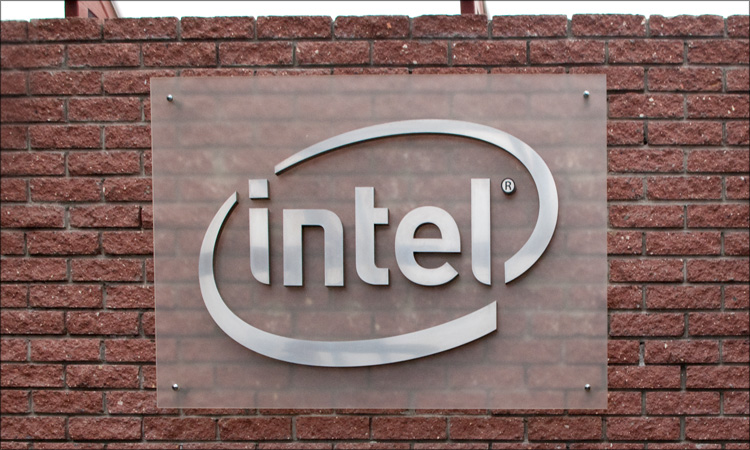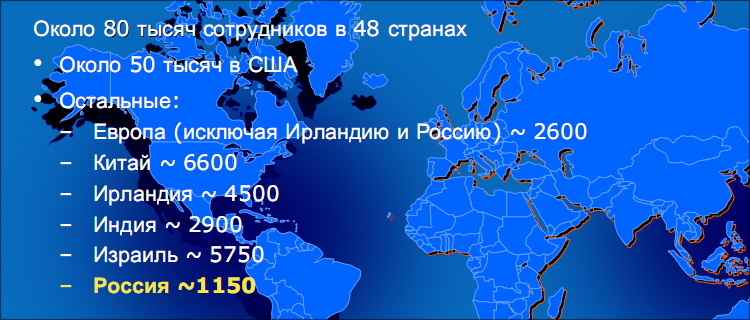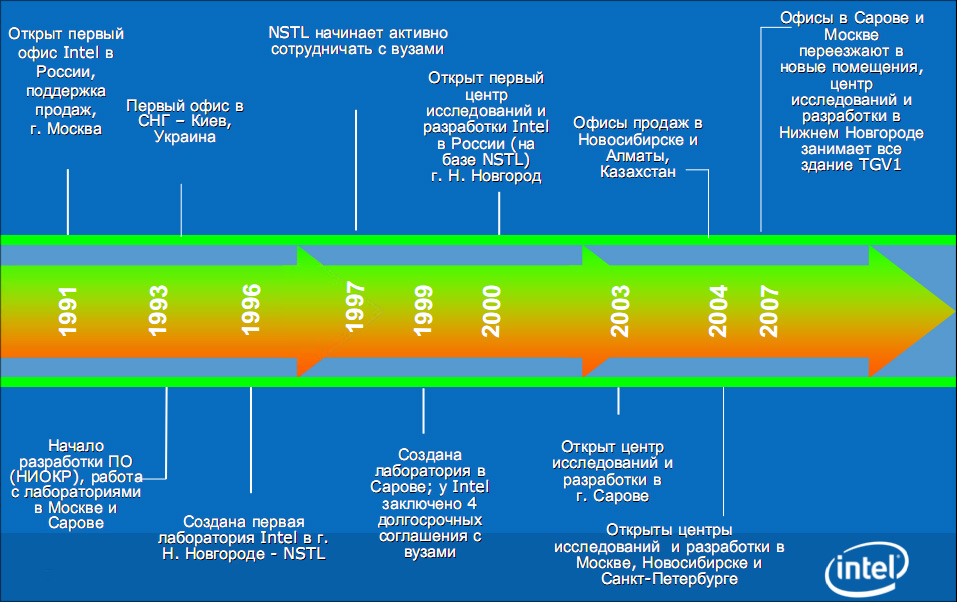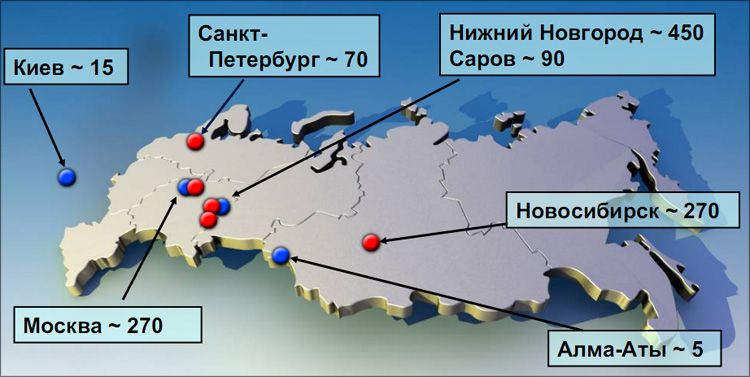Intel in Russia
Last year I wrote about the Moscow office of the corporation, and by and large, I posted only photos. Now I just want to tell you, but already about the Nizhny Novgorod office, one of the main offices of the company in Russia - I returned from it just a few days ago.

But first, I will try to tell about what Intel is doing in Russia - apparently, for many it still remains a mystery.
I will begin, as always, from afar. It's no secret that Intel is the world leader in semiconductor devices and microprocessors, and is also a recognized leader in the field of innovation.
')
Inside the company, it is considered that there were three "versions" of the corporation - Intel 1.0, 2.0 and 3.0, respectively. It all started from the end of the 60s (to be more precise, in 1968) and lasted until the mid-70s - all this time the main business of the company was semiconductor memory.

The “second version” of the company began from the mid-70s and lasted until almost the 90s - as it is not difficult to guess, microprocessors became the main vector of the company. About any Pentiums still out of the question.
And in the late 90s, the corporation realized that it was moving along a new stage of development - Intel 3.0 became involved in platforms. In a nutshell, the question “What is a platform?” Cannot be answered, but now this is not the point; although it would be interesting to listen to the answers to the question "What was the name of the first platform from Intel?")
The fact that there is now, many are in general. Intel is a global company and currently consists of more than 80 thousand people in 48 countries, working in more than 300 offices around the world; the bulk of production is concentrated, as it is not difficult to guess, in the USA.

As for Russia, everything began in 1991, when the first Intel sales office opened in Moscow. After 2 years, he began to cooperate with various Russian companies in the field of software research and development, one of which (particularly successful) was in the city of Sarov (as far as I know, this city is still considered secret as one of the nuclear centers - understandably that in 1993 the creation of an office in this city was out of the question). In 2000, the Nizhny Novgorod Intel Research and Development Center was created - at the same time, the corporation began to actively cooperate with leading universities in the country.
The next few years became especially fruitful - in 2003 (that is, 10 years later), a research and development center opened in Sarov, and in 2004 additional offices opened in Almaty, Kazakhstan and Novosibirsk. In the same year, 3 more large Intel R & D centers appeared in Moscow, Novosibirsk and St. Petersburg.

NTSL - Nizhniy Software Laboratory
In 2007, the company completely redeemed the Nizhny Novgorod office building and the corresponding piece of land, which made everyone aware that it was serious here for a long time. At the moment it is the only office in Eastern Europe, which is not rented.
Of the above 80,000 employees, Russia accounts for very little - about 1,150 people. By the way, according to the US Department of State classification, Russia and China belong to the countries “with controlled computing resources”, therefore these territories are subject to serious limitations on research in “difficult” areas, so nothing remains to be done to develop those things that require simplified licensing. - for example, software, wireless data transmission technologies, etc.
The approximate distribution of employees by office in Russia is as follows (the red dots are research and development, the blue ones are sales and marketing):

The Nizhny Novgorod office has more than half of the engineering staff of a corporation in Russia. Most of the office staff are graduates of Nizhny Novgorod universities. Over the past 5 years in Russia, the company has become an employer for more than 2,000 people (including interns): Moscow (~ 650), Nizhny Novgorod (~ 800), Novosibirsk (~ 300), St. Petersburg (~ 100) and Sarov (~ 100)
Well, the most interesting, for which the whole text was written. In general, in the company's activities in Russia and the CIS, the following key vectors of activity can be identified that are closely intertwined. In short (without details), this is:
- Development of ecosystem and information technology market
- Advanced research in the field of microprocessor architectures
- Development of hardware platform components
- Writing compilers and libraries for programmers
- strategic investments
- Social responsibility (all kinds of social activities, including education)
- Work with federal and regional authorities
Some of the points have already been told, about some more will tell. Very soon - directly about the Nizhny Novgorod office itself, about the interesting features of the building, data center, research directions, social responsibility and something else;) Stay connected!
Successes!

But first, I will try to tell about what Intel is doing in Russia - apparently, for many it still remains a mystery.
I will begin, as always, from afar. It's no secret that Intel is the world leader in semiconductor devices and microprocessors, and is also a recognized leader in the field of innovation.
')
Inside the company, it is considered that there were three "versions" of the corporation - Intel 1.0, 2.0 and 3.0, respectively. It all started from the end of the 60s (to be more precise, in 1968) and lasted until the mid-70s - all this time the main business of the company was semiconductor memory.

The “second version” of the company began from the mid-70s and lasted until almost the 90s - as it is not difficult to guess, microprocessors became the main vector of the company. About any Pentiums still out of the question.
And in the late 90s, the corporation realized that it was moving along a new stage of development - Intel 3.0 became involved in platforms. In a nutshell, the question “What is a platform?” Cannot be answered, but now this is not the point; although it would be interesting to listen to the answers to the question "What was the name of the first platform from Intel?")
The fact that there is now, many are in general. Intel is a global company and currently consists of more than 80 thousand people in 48 countries, working in more than 300 offices around the world; the bulk of production is concentrated, as it is not difficult to guess, in the USA.

As for Russia, everything began in 1991, when the first Intel sales office opened in Moscow. After 2 years, he began to cooperate with various Russian companies in the field of software research and development, one of which (particularly successful) was in the city of Sarov (as far as I know, this city is still considered secret as one of the nuclear centers - understandably that in 1993 the creation of an office in this city was out of the question). In 2000, the Nizhny Novgorod Intel Research and Development Center was created - at the same time, the corporation began to actively cooperate with leading universities in the country.
The next few years became especially fruitful - in 2003 (that is, 10 years later), a research and development center opened in Sarov, and in 2004 additional offices opened in Almaty, Kazakhstan and Novosibirsk. In the same year, 3 more large Intel R & D centers appeared in Moscow, Novosibirsk and St. Petersburg.

NTSL - Nizhniy Software Laboratory
In 2007, the company completely redeemed the Nizhny Novgorod office building and the corresponding piece of land, which made everyone aware that it was serious here for a long time. At the moment it is the only office in Eastern Europe, which is not rented.
Of the above 80,000 employees, Russia accounts for very little - about 1,150 people. By the way, according to the US Department of State classification, Russia and China belong to the countries “with controlled computing resources”, therefore these territories are subject to serious limitations on research in “difficult” areas, so nothing remains to be done to develop those things that require simplified licensing. - for example, software, wireless data transmission technologies, etc.
The approximate distribution of employees by office in Russia is as follows (the red dots are research and development, the blue ones are sales and marketing):

The Nizhny Novgorod office has more than half of the engineering staff of a corporation in Russia. Most of the office staff are graduates of Nizhny Novgorod universities. Over the past 5 years in Russia, the company has become an employer for more than 2,000 people (including interns): Moscow (~ 650), Nizhny Novgorod (~ 800), Novosibirsk (~ 300), St. Petersburg (~ 100) and Sarov (~ 100)
Well, the most interesting, for which the whole text was written. In general, in the company's activities in Russia and the CIS, the following key vectors of activity can be identified that are closely intertwined. In short (without details), this is:
- Development of ecosystem and information technology market
- Advanced research in the field of microprocessor architectures
- Development of hardware platform components
- Writing compilers and libraries for programmers
- strategic investments
- Social responsibility (all kinds of social activities, including education)
- Work with federal and regional authorities
Some of the points have already been told, about some more will tell. Very soon - directly about the Nizhny Novgorod office itself, about the interesting features of the building, data center, research directions, social responsibility and something else;) Stay connected!
Successes!
Source: https://habr.com/ru/post/106532/
All Articles